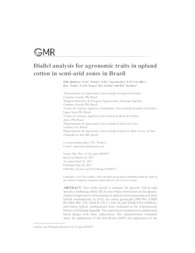Diallel analysis for agronomic traits in upland cotton in semi-arid zones in Brazil.
Diallel analysis for agronomic traits in upland cotton in semi-arid zones in Brazil.
Author(s): QUEIROZ, R. R.; FARIAS, F. J. C.; CARVALHO, L. P. de; NEDER, D. G.; SOUZA, L. S. S.; FARIAS, F. C.; TEODORO, P. E.
Summary: This study aimed to estimate the general- (GCA) and specific-combining ability (SCA) and obtain information on the genetic control of agronomic traits among six upland cotton genotypes and their hybrid combinations. In 2015, six cotton genotypes (FM 993, CNPA 04-2080, PSC 355, TAM B 139-17, IAC 26, and TAMCOT-CAMD-E), and fifteen hybrid combinations were evaluated at the Experimental Station of Embrapa Algodão. The experiment consisted of a randomized block design with three replications. The characteristics evaluated were: the appearance of the first flower (AFF); the appearance of the Genetics and Molecular Research 16 (3): gmr16039677 first boll (AFB); plant height (PH); the weight of one boll (BW); lint percentage (LP); cotton seed yield (CSY); and cotton fiber yield (LY). Significant genetic variability was observed for all the traits studied, which is fundamental for the formation of populations that maximize genetic gains. Additive effects were predominant for AFF, AFB, PH, and LP. Non-additive effects were predominant for CSY, LY, and BW. Genotypes FM 993 and CNPA 04-2080 presented the highest GCA estimates for CSY, LP, and LY, as well as the highest means, being indicated for breeding programs that aim at the improvement of these traits. The best hybrid combinations were FM 993 x PSC 355, FM 993 x TAMCOT-CAMD-E, CNPA 04-2080 x TAM B 139-17, PSC 355 x IAC 26, and TAM B 139-17 x IAC 26, since they presented means associated with positive and high SCA estimates for CSY, LP, LY, and at least one of their parents presented high GCA.
Publication year: 2017
Types of publication: Journal article
Unit: Embrapa Cotton
Keywords: Algodão, Cotton, Cotton fibers, Earliness, Fibers, Gossypium hirsutum
Observation
Some of Embrapa's publications are published as ePub files. To read them, use or download one of the following free software options to your computer or mobile device. Android: Google Play Books; IOS: iBooks; Windows and Linux: Calibre.
Access other publications
Access the Agricultural Research Database (BDPA) to consult Embrapa's full library collection and records.
Visit Embrapa Bookstore to purchase books and other publications sold by Embrapa.

